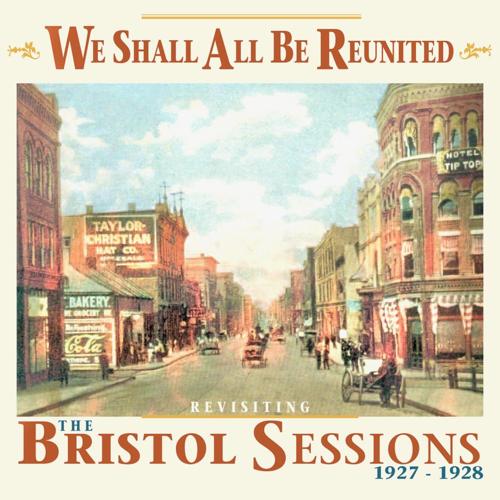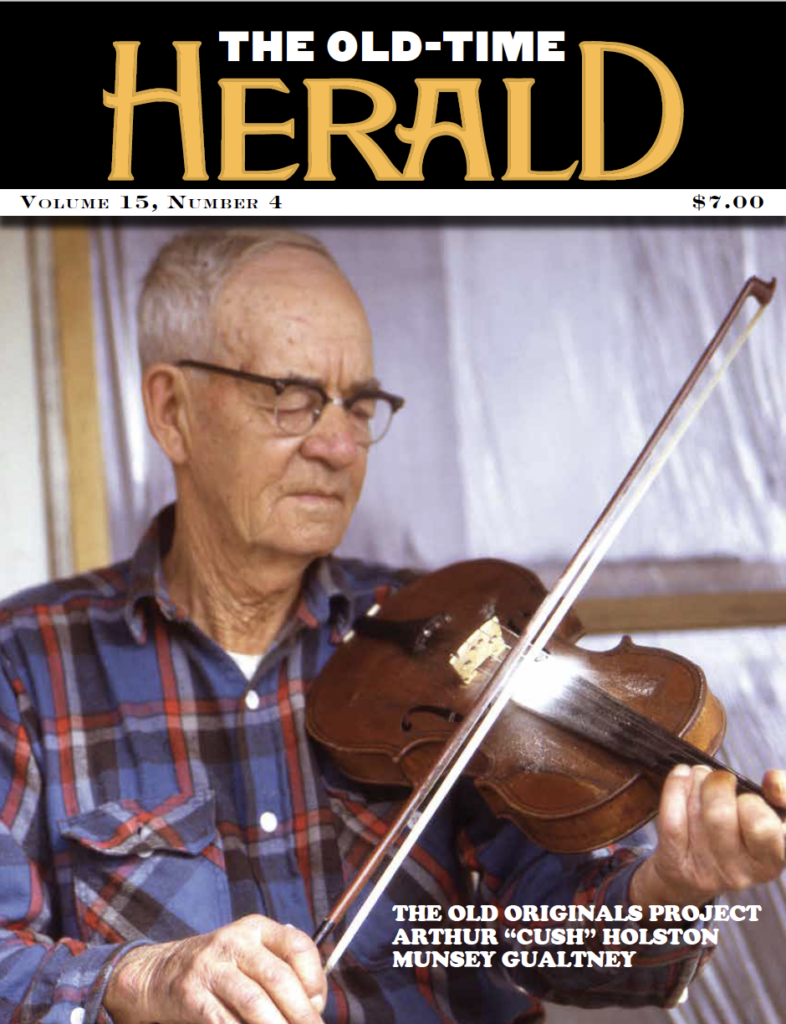In 1927 and 1928, Victor Records sent Ralph Peer to Bristol, Tennessee, to record country musicians, in what became known as the Bristol Sessions. In 1987, the Country Music Foundation put out a two-LP set drawn from these recordings, and in 2002, they released a CD called The Bristol Sessions, Vol. 1. (No subsequent volumes have been issued.) In 2011, Bear Family Records released a five-CD box set entitled The Bristol Sessions which contained the entirety of Victor Records’ 1927 and 1928 Bristol sessions, including alternate takes. We Shall All Be Reunited is a CD containing a selection of tracks from those same sessions. If you already own the five-CD box set, you’ll already have all the tracks that appear on this new release.
However, if you do not own that box set (or even if you do), this new one is well worth acquiring, thanks to Ted Olson’s expert curation. The 26 tracks span quite a wide range, with lots of sacred singing, fiddle tunes, sentimental Tin Pan Alley songs, and even a couple of solo harmonica pieces. Even within those categories, there’s plenty of variety. It’s a terrific listen, and Olson’s song notes are excellent. The booklet also includes an extensive essay by Olson. His point, that it is erroneous to promote the Bristol Sessions as point zero (the Big Bang) of country music, is well taken, but he could have said it more succinctly. (The part where he quotes Joe Wilson about the origin of the word “bunkum” is particularly worthwhile.)
Some of the tracks are ones that I’ve been listening to for years (the Carters’ “Orphan Child”) but some of the artists, like the Palmer Sisters, were unknown to me. I can honestly say that I enjoyed every single song, and the technical side of this production (transfers, remastering) is exemplary. A few annoyances: the AIFF tracks on the download were not labelled, and the booklet page that lists the tracks lists them by artist first, rather than by the song title, making it a little harder to track down a particular selection. Also, even though they are two of my favorite songs here, I do not understand reasoning behind the inclusion of the two tracks (“Shine On Me” and “Old Shoes and Leggin’s’”) which also appeared on the Harry Smith Anthology of American Folk Music. Yes, they’re wonderful, but they have been in circulation since 1952.
One of the things I love most about early old-time vocalizing is the lack of scenery-chewing. In B.F. Shelton’s “Oh Molly Dear,” clearly adapted from an unaccompanied ballad, the emotion is held in check, making for a more powerful and much more menacing delivery. The point of view shifts during the song, making it murky and mysterious, like a film in which the point of view keeps changing. The same matter-of-fact delivery characterizes Blind Alfred Reed’s “The Wreck of the Virginian,” which is an unissued take. It’s pretty great, and I’m not sure why the other was issued instead of this one. As a fiddler who sings, I admire the artistry of his simultaneous vocalizing and fiddling.
All the fiddle tunes here include singing, apparently added at the express request of Ralph Peer, who suspected (and he was right) that records with singing would sell better than purely instrumental records. “Johnny Goodwin” is a version of “The Girl I Left Behind Me” by the Bull Mountain Moonshiners, featuring fiddler Charles McReynolds (grandfather of Jim and Jesse McReynolds of bluegrass fame). Norman Edmonds and J.P. Nester’s “Black-Eyed Susie,” the flip side of their more famous “Train On the Island” (well known from the Smith Anthology), is a classic example of pure and perfect mountain heterophony. Nester holds nothing back with his banjo playing and Edmonds’ fiddling is splendid. J.P. Nester was later asked to record in New York, but he did not want to travel. Too bad. I also would love to hear the two unissued selections that they recorded, but those are probably lost to us.
Two recordings of “Susanna Gal” are included. Dad Blackard’s “Susanna Gal” is more up-tempo and you sure can hear the banjo! I like the B part, which is different from the other B parts I’ve heard for this tune. The Blackard and Shelor families have continued to produce great musicians including Sammy Shelor. A somewhat more stately version, entitled “Your Blue Eyes Run Me Crazy,” by the West Virginia Coon Hunters, has the more usual B part. There’s singing here too, but don’t listen too closely to the lyrics; they are offensive by modern-day standards.
What of the two most famous groups to emerge from the Bristol Sessions? “Poor Orphan Child” by the Carter Family was on their very first record, backed by “The Wandering Boy.” Like Karnes’ song, the backup goes at a tremendous pace which keeps the vocals from being too lugubrious. Also like Karnes’ performance, the song’s emotional power is amplified by the restrained delivery, a little bit like acting for film versus the stage. The vocal duet on this song is, to my mind, one of the most beautiful of all the Carter Family’s records, combining A.P.’s strong singing and Sara’s lovely high register. (Maybelle plays guitar here but doesn’t sing.)
The Jimmie Rodgers track “Sleep Baby Sleep” practically put ME to sleep – it displays the pop-singer aspect of the Yodeling Brakeman, in a sharp contrast to the plain-spoken strength of “Orphan Child.” However, the yodeling woke me right up! Other tracks that would not have been my first choices include the equally (if not more) lugubrious “The Longest Train” (Tenneva Ramblers) – which is not actually the first recording of this song, better known as “In the Pines”; it was recorded a few years earlier by Dock Walsh. For a more interesting early version, listen to Peg Leg Howell’s “Rolling Mill Blues,” recorded in 1929.
Two solo harmonica pieces are included. “Rain Crow Bill,” Henry Whitter’s showcase tune, uses varied rhythms, “dwells,” and implied chord changes, which take it to some unexpected places and hold the listener’s interest. This tune was subsequently recorded by both Sonny Terry and Doc Watson. “Narrow Gauge Blues” by El Watson is one of only a few recordings made by a Black musician at the Bristol sessions. In this railroad train harmonica standard known by many names, Watson bends the notes, gallops away, and gets a gorgeous rich tone out of his mouth harp.
The only other Black performers to participate in the Bristol Sessions were Tarter and Gay, guitarists who recorded “Unknown Blues.” This 12-bar blues is far more sophisticated than anything else here, being in the Lonnie Johnson/Eddie Lang vein, with exciting interplay between the two guitars, and polished singing. Unfortunately Tarter and Gay only made one record – two sides.
“New Orleans Is the Town I Like Best” was recorded by the Carolina Twins, who were not related; they were Gwin (Gwen, Gwyn) Foster (of the Carolina Tar Heels) and David Fletcher. The lyrics were recycled in 1933 in Ashley & Foster’s “My North Carolina Home.” This earlier rendition includes some nice yodeling, presumably by Fletcher (since one would think that if Gwin Foster was a yodeler, some would have turned up on one of his many other recordings). Clarence Greene’s “Little Bunch of Roses” is the seed of Flatt & Scruggs’ “Don’t This Road Look Rough and Rocky,” recorded in 1954. Howard-Peak (the Blind Musicians) recorded “I Cannot Be Your Sweetheart,” a strange choice with lyrics like “which I could read in her eyes” and others which refer directly to sight.
Very few humorous songs were included here, although what was considered funny in 1927 doesn’t always play well 95 years later. “Old Shoes and Leggin’s” was collected widely in England and Scotland as far back as the 18th century. Eck Dunford’s band is very much a family affair: he was related through marriage to Hattie Stoneman and is accompanied here by her, by her husband Ernest, and by her brother Bolen Frost. The CD begins with the first song to be recorded at the first Bristol session, by the Smyth County Ramblers, led by fiddler Jack Pierce (of the Tenneva Ramblers). “Ticklish Reuben,” sometimes called “The Laughing Song,” was already an old standard by 1928, having been first recorded by Cal Stewart in 1902 and by Uncle Dave Macon (as “Something’s Sure To Tickle Me”) in 1926. Thankfully the Smyth County Ramblers omitted the annoying laughing section found in other versions.
“Soldier’s Poor Little Boy” is a rare example of Black and White musicians recording old-time music together. It’s sung by the Johnson Brothers, who were White, and the Black harmonica player El Watson accompanies them. His playing is pretty wooden here compared to his solo piece and I suspect he was hearing the song for the first time. The “poor orphan” songs of this era (the Carters’ “Orphan Child” is another) have a terrible significance today with so many homeless and the Ukraine war (and too many other wars). This song, however, has a happy ending: the rich lady takes in the poor little orphan instead of leaving him to starve and freeze to death.
The many examples of sacred singing are extraordinary and at least three different styles are included. A more formal style popularized by the Stamps Quartet (who were recorded at the Bristol Sessions but do not appear on this CD) is represented here by the Alcoa Quartet and the Palmer Sisters, whom I had not heard before. The timbre of the three teenage-girl voices on “We’ll Sing On That Shore”creates a very different sound from the slickness of the Alcoa Quartet. Their sisterly blend makes use of unisons and the parts separate and come back together, so that sometimes there are two notes sounding and at other times three, one of the hallmarks of old-time country harmony singing that sets it apart from bluegrass.
The large choral group numbers are standouts. You may remember Ernest Phipps & His Holiness Singers’ “Shine On Me” from the Harry Smith Anthology. The instrumental texture evokes a church organ, although it is actually a fiddle and guitar. The female voices pipe the melody in a high clear range, with no vibrato, and the ad hoc nature of the vocal stacking creates a country baptism feel (as opposed to reading from a hymnal.) When they shift tempos and burst into unrestrained joyful exuberance and hand-clapping, they sound like an actual congregation, rather than an ensemble with every single note worked out and rehearsed. If you enjoy this, check out the recordings by the Holy Ghost Sanctified Singers (probably a pseudonym for the Memphis Jug Band).
“Sweeping Through the Gates” by Ernest Stoneman and his Dixie Mountaineers has the feel of a rural Salvation Army band, with a rather unusual instrumental accompaniment (two fiddles, guitar and organ). The band included Hattie Stoneman and her sister Irma Frost as well as Kahle and Edna Brewer, Uncle Eck Dunford, and several other male singers.
The other choral group included here is an actual 20-member church choir dubbed the Tennessee Mountaineers, who recorded a hymnal standard, “Standing On the Promises.” The layered harmonies and section singing make for a lush, velvety texture, and the sound quality is fantastic! You couldn’t do better now, nearly 100 years later. I’ve been listening to it over and over and over.
The CD closes with the title track, Alfred Karnes’ “We Shall All Be Reunited,” in which Karnes’ intense singing, with its elongated vowels, ultra-clear enunciation, and subtle ornaments, packs a truly expressive and emotional punch. It was Karnes’ last issued recording, and Olson intended for it to serve here as an epitaph, not only for Karnes but for all the wonderful old-time music recorded during the 1920s.


Leave a Reply